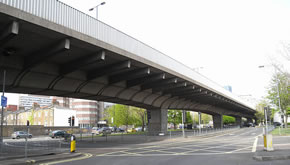Hammersmith Flyover Works Finally Complete
£100 million refurb caused two years of disruption
Major work to strengthen the Hammersmith Flyover in west London is now complete meaning an end to the regular weekend and night time closures which have caused traffic problems in West London.
Work still needs to be done to clear the work site around the flyover, with all local roads returning to normal by 'late autumn'.
The refurbishment, which has seen engineers over the past two years, means that the sixties flyover has now been fully restored and strengthened according to Transport for London (TfL). They claim that the flyover is now safe to use for decades to come and will require less regular maintenance work, meaning less congestion and traffic delays in the future.
Since October 2013, restoration work has been carried out by TfL, its Principal Contractor Costain and main sub-contractors including Freyssinet and SSL, to strengthen 11 of the flyover's 16 spans after an initial five were strengthened in 2012. This work – part of TfL’s wider £4bn Road Modernisation Plan – has been primarily carried out overnight to reduce disruption to road users and residents.
The work has included:
• New tensioning cables – totalling 6.5km in length – installed and fully tensioned, restoring strength within the structure;
• The entire flyover re-waterproofed and resurfaced with new drainage installed within the structure;
• More than 150 tonnes of steel beams and bars installed inside the flyover to hold the new tensioning system and reinforce the concrete;
• Two five-tonne expansion joints within the carriageway were replaced, allowing the structure to flex as traffic moves across it;
• All 34 bearings supporting the flyover have been replaced, allowing it to adapt to weather conditions and expand in the summer and shrink in the winter by up to 180mm.
Garrett Emmerson, Chief Operating Officer for Surface Transport at TfL, said: "The work carried out on the Hammersmith Flyover in the last two years has been vital to ensure that the structure, a key London road artery, remains safe for many years to come.
“The engineering prowess of the team at Hammersmith has meant that the flyover has been kept open to traffic for more than 90 per cent of the duration of the work, and I would like to thank all local residents and road users for having borne with us whilst the work was carried out.”
Edmund King, AA president said: “TfL engineers working night and day on the Hammersmith flyover has now paid off. When the flyover was found to be unsafe just before the Olympics it was a nightmare. Since then we have had a refurbishment scheme that has been highly innovative and which has always sought to reduce the impact of the inevitable repair works on traffic on this vital strategic route. “
The Hammersmith Flyover refurbishment is part of TfL’s £4bn Road Modernisation Plan, which they say represents the biggest investment in London’s roads in a generation, including hundreds of projects to transform and modernise key junctions, bridges, flyovers and tunnels.
TfL is continuing to work closely with Hammersmith and Fulham council to make Hammersmith gyratory safer and more accessible for cyclists, as part of their wider borough cycling improvement strategy. Plans are also underway to install a new Santander Cycles docking station underneath the flyover, providing space for more than 50 bikes. Subject to planning permission, the docking station could be in place by early 2016.
Hammersmith Broadway/Shepherd's Bush Rd

Hammersmith Bridge Rd

Talgarth Rd/Butterwick

A4 Great West Rd/Macbeth Street

September 4, 2015
